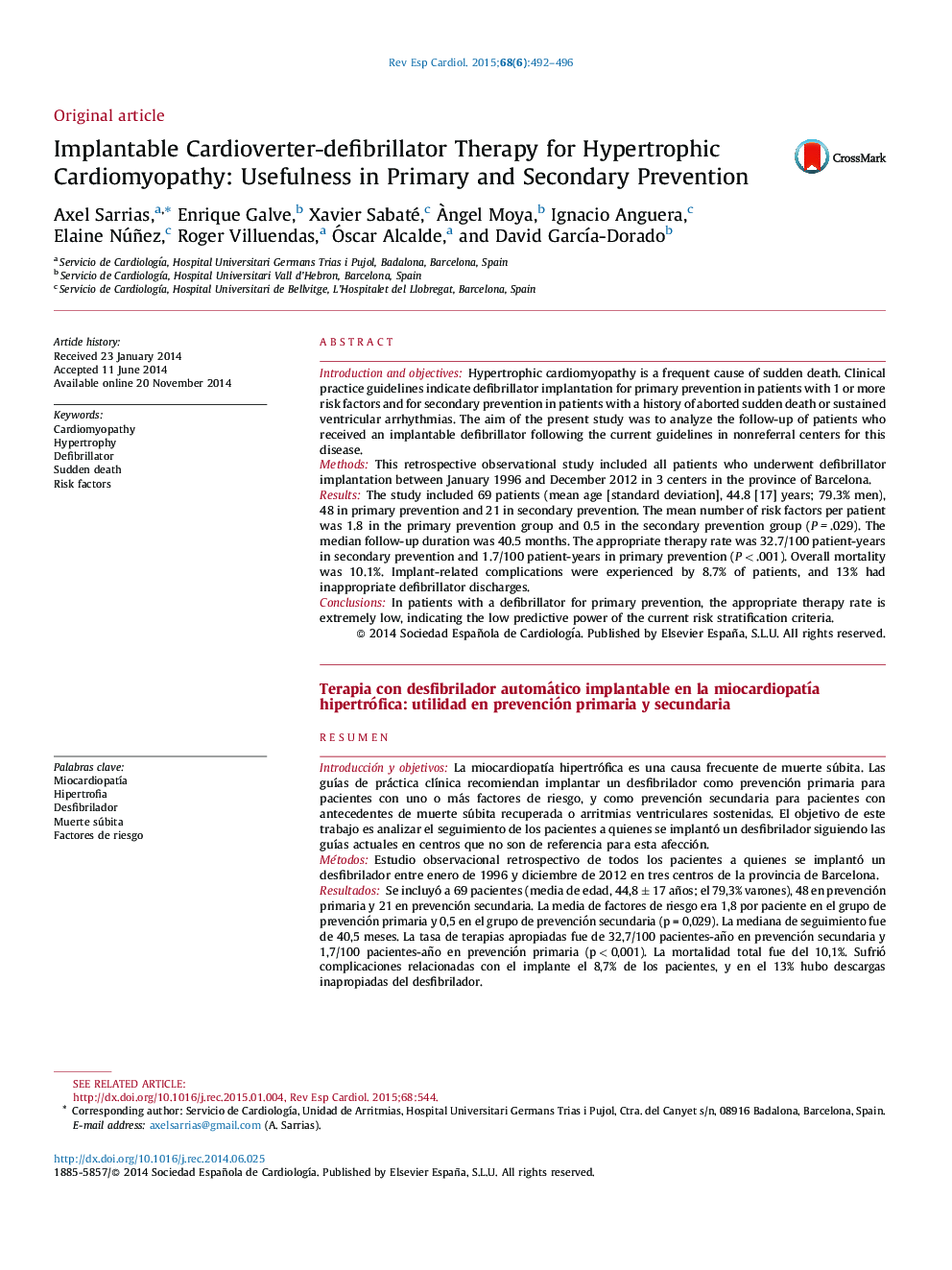| کد مقاله | کد نشریه | سال انتشار | مقاله انگلیسی | نسخه تمام متن |
|---|---|---|---|---|
| 3016401 | 1182081 | 2015 | 5 صفحه PDF | دانلود رایگان |

Introduction and objectivesHypertrophic cardiomyopathy is a frequent cause of sudden death. Clinical practice guidelines indicate defibrillator implantation for primary prevention in patients with 1 or more risk factors and for secondary prevention in patients with a history of aborted sudden death or sustained ventricular arrhythmias. The aim of the present study was to analyze the follow-up of patients who received an implantable defibrillator following the current guidelines in nonreferral centers for this disease.MethodsThis retrospective observational study included all patients who underwent defibrillator implantation between January 1996 and December 2012 in 3 centers in the province of Barcelona.ResultsThe study included 69 patients (mean age [standard deviation], 44.8 [17] years; 79.3% men), 48 in primary prevention and 21 in secondary prevention. The mean number of risk factors per patient was 1.8 in the primary prevention group and 0.5 in the secondary prevention group (P = .029). The median follow-up duration was 40.5 months. The appropriate therapy rate was 32.7/100 patient-years in secondary prevention and 1.7/100 patient-years in primary prevention (P < .001). Overall mortality was 10.1%. Implant-related complications were experienced by 8.7% of patients, and 13% had inappropriate defibrillator discharges.ConclusionsIn patients with a defibrillator for primary prevention, the appropriate therapy rate is extremely low, indicating the low predictive power of the current risk stratification criteria.
ResumenIntroducción y objetivosLa miocardiopatía hipertrófica es una causa frecuente de muerte súbita. Las guías de práctica clínica recomiendan implantar un desfibrilador como prevención primaria para pacientes con uno o más factores de riesgo, y como prevención secundaria para pacientes con antecedentes de muerte súbita recuperada o arritmias ventriculares sostenidas. El objetivo de este trabajo es analizar el seguimiento de los pacientes a quienes se implantó un desfibrilador siguiendo las guías actuales en centros que no son de referencia para esta afección.MétodosEstudio observacional retrospectivo de todos los pacientes a quienes se implantó un desfibrilador entre enero de 1996 y diciembre de 2012 en tres centros de la provincia de Barcelona.ResultadosSe incluyó a 69 pacientes (media de edad, 44,8 ± 17 años; el 79,3% varones), 48 en prevención primaria y 21 en prevención secundaria. La media de factores de riesgo era 1,8 por paciente en el grupo de prevención primaria y 0,5 en el grupo de prevención secundaria (p = 0,029). La mediana de seguimiento fue de 40,5 meses. La tasa de terapias apropiadas fue de 32,7/100 pacientes-año en prevención secundaria y 1,7/100 pacientes-año en prevención primaria (p < 0,001). La mortalidad total fue del 10,1%. Sufrió complicaciones relacionadas con el implante el 8,7% de los pacientes, y en el 13% hubo descargas inapropiadas del desfibrilador.ConclusionesEn los pacientes portadores de desfibrilador como prevención primaria, la tasa de terapias apropiadas es excesivamente baja, lo que indica que los criterios actuales de estratificación de riesgo tienen bajo poder predictivo.
Journal: Revista Española de Cardiología (English Edition) - Volume 68, Issue 6, June 2015, Pages 492–496